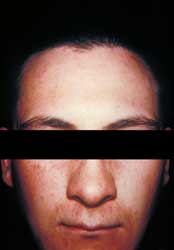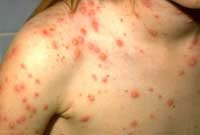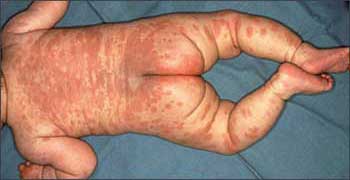
Tackling the common onesMost of us have gone through the common childhood illnesses of chicken pox, measles and rubella without too much difficulty. Yet when a child gets a fever with the characteristic rash, we are anxious. The usual practice is not to intervene in the hope that it will get better in due course. This does happen most of the time for common illnesses like measles, rubella and chickenpox. Yet, there are exceptions, with the above diseases causing complications and also other illnesses like "Kawasaki" needing treatment, monitoring and proper follow up. Although there are a number of diseases which gives rise to fever and skin rash, MediScene focuses this month on some of the common conditions. An important feature in childhood fevers with a rash is that some of them can easily be prevented by vaccination. Measles and rubella are preventable by vaccination and these vaccines are freely available for all children under the expanded programme of immunization. Rubella is not as common as earlier, due to the immunization programme. During childhood it is a mild disease but it can be extremely dangerous if it occurs during pregnancy, as it could cause a number of problems in the foetus. In a child, it starts as a low grade fever, a general feeling of being unwell and a mild sore throat after 2 to 3 weeks of getting exposed to a patient with rubella. Sometimes the infection could go unnoticed. During the second or third day of the illness, a rash appears, with tiny red spots over the body, which spontaneously resolves in two to three days.
However, a child could spread the disease to other people even one week before the rash appears till four to five days after. Therefore it's important to keep the child away from others especially from pregnant women for 7 days after the rash appears. The disease spreads by direct contact with infected people, by breathing the same air which contains tiny droplets in the respiratory secretions of the patient. There is no specific treatment needed apart from paracetamol, when there is fever. Prevention of rubella is crucial, to prevent abnormalities in the foetus. Parents are advised to give their children this vaccine at the age of three years. Adults who have not had this vaccine can also take it. MOH clinics and hospitals provide it free of charge for women between 14 to 40 years of age. Once you get the vaccine, you are not supposed to get pregnant for another three months. Measles Measles too is not seen as often as it was in earlier days due to the immunization programme. All children get the measles vaccine at 9 months and again at 3 years. Measles gives rise to high fever, a general feeling of being unwell and symptoms of a respiratory infection like runny nose, cough and red tearing eyes. After about 3 to 4 days from the onset a red rash appears, starting from the area behind the ears, spreading to the back and the hips the next day and onto the legs. There will be large swollen blotches on the face and the rash on the body will have both tiny red spots and patches, which last for about 4 to 7 days. Usually a patient with measles can spread the disease to others during the initial period with fever and cough up to about the first two three days of the rash. The spread is similar to rubella. Unlike rubella, measles can have serious consequences in children. It can depress the child's immune system so that various other infections can set in, particularly in children who are malnourished. Other than that, bacterial infections occurring on top of this viral infection, pneumonia, there can be middle ear infections. On rare occasions, serious neurological problems can occur too. Therefore getting the measles vaccine is mandatory for any child unless under special circumstances you may need to delay it. Chickenpox Unlike the other two, vaccination against chickenpox is not widely practised during childhood. The vaccine is available in the private sector and is a little expensive. Also chickenpox, once contracted during childhood, does not usually cause complications. After about 2 to 3 weeks from being in contact with a person having chickenpox, the illness starts, with fever, body aches, and a general feeling of being unwell. Then the rash appears on the face and trunk and spreads onto the limbs. It is itchy. Initially the rash is red tiny spots that occur in crops. Then they turn into clear fluid filled blisters which in turn become opaque. Ultimately they dry into crusts. These blisters occur in the external skin as well as the mucous membranes, the soft skin in the mouth, genitals etc. The disease spreads by direct contact with vesicular fluid, breathing the air containing vesicular fluid and tiny droplets in the respiratory secretions of the patient. A patient can spread the disease to others 2 to 3 days before the illness up to the crusting of lesions.
During childhood the disease is mild and usually not complicated. But in the adult and patients with depressed immunity due to steroid treatment and cancer chemotherapy, it can have problems. The complications include pneumonia, secondary bacterial infections of the blisters, neurological problems and a condition called 'hemorrhagic varicella'. Unlike the other two illnesses chickenpox has an effective treatment, acyclovir. This should be taken on the first day of the rash, as soon as possible, to be effective. It does not cure the disease but reduces the severity of the symptoms. For fever, paracetamol is a safe option. But avoid aspirin and other non steroidal anti-inflammatory drugs like ibuprofen in children. The patient needs to be in clean, dry, loose-fitting cotton clothes. Once you have had chickenpox, you have lifelong immunity against this infection. But in some patients the virus can remain dormant in the nervous system and after sometime can get activated causing very painful blistering in one particular region. This condition is called shingles or herpes Zoster. This is not a sexually transmitted disease as some people fear. It is just reactivation of the chickenpox virus. This too is treated with acyclovir.
Although not heard of as frequently as the others, Kawasaki disease is an important disease that occurs in children. The cause is not known but the disease is a combination of high fever, red eyes, red cracked lips, skin rash without blisters, swollen hands and feet, rash in the hands and feet, reddened tongue, enlarged lymph node in the neck and rise in the platelet count in the blood. The child should be admitted to hospital and monitored. Treatment with aspirin is essential. Usually for other childhood illnesses, aspirin is hardly ever indicated. A child's blood vessels can get diseased due to this illness so follow-up care is needed to rule out possible damage to the vessels in the heart. |
|
||||||
|| Front
Page | News | Editorial | Columns | Sports | Plus | Financial
Times | International | Mirror | TV
Times | Funday
Times | Medi Scene || |
| |
Reproduction of articles permitted when used without any alterations to contents and the source. |
© Copyright
2008 | Wijeya
Newspapers Ltd.Colombo. Sri Lanka. All Rights Reserved. |


